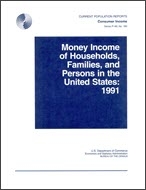Money Income of Households, Families, and Persons in the United States: 1991
Money Income of Households, Families, and Persons in the United States: 1991
Note
Beginning with this report, the experimental Consumer Price Index (CPI-U-X1) will be used in the P-60 Consumer Income reports as a deflator in making historical comparisons involving income data. In the past, the CPI-U index was primarily used in making income comparisons over time. (See Appendix A, "Bureau of Labor Statistics' Statement on the Use of the CPI-U-X1," and the Current Population Report, P-60, No. 174, Money Income of Households, Families, and Persons in the United States: 1990, for a discussion of the uses of the CPI-U-X1 and CPI-U as price deflators.)
In January 1992, a new educational attainment question comparable to that used in the 1990 census of population was introduced in the Current Population Survey (CPS). Consequently, data on educational attainment from the 1992 CPS are not directly comparable to CPS data for prior years. A discussion of the change in the educational attainment item can be found in the descriptive text of this report.
The estimates for March 1990, 1991, and 1992 in this report are inflated to national population controls by age, race, sex. and Hispanic origin. The population controls are based on results of the 1980 census carried forward to 1990, 1991, and 1992. The estimates in this report, therefore, may differ from estimates that would have been obtained using 1990 census results brought forward to the survey date. Population controls incorporating 1990 census results will be used for survey estimation beginning in 1993.
Introduction
This report presents data on the income of households, families, and persons in the United States for the calendar year 1991. These data were compiled from information collected in the March 1992 Current Population Survey (CPS) conducted by the Bureau of the Census. The survey consisted of approximately 60,000 households nationwide.
The official income estimates in this report are based solely on money income before taxes and do not include the value of noncash benefits such as food stamps, Medicare, Medicaid, public housing, and employer-provided fringe benefits. For a discussion of the effects of taxes and noncash benefits on income in 1991, see Current Population Reports, Series P-60, No. 182-RD, Measuring the Effect of Benefits and Taxes on Income and Poverty: 1979 to 1991.
This report begins with a section on household income, with year-to-year comparisons by region, age of householder, type of residence, race and Hispanic origin, and type of household. This is followed by sections on changes in family income by type of residence, family composition, race and Hispanic origin, and size of family. Sections on the income of year-round, full-time workers, per capita income, income inequality, and State income data follow the family section.
A section on health insurance coverage is included in this report for the first time. This section discusses health insurance coverage of persons by type of coverage and the variation in health insurance coverage by State.
The CPS is a cross-sectional survey which can provide a series of snapshots of the socioeconomic conditions that exist at different fixed points in time. To demonstrate the extent to which individuals and population subgroups experience year-to-year changes in economic well-being, information from the Survey of Income and Program Participation (SIPP) is also included in this report. See the section entitled "Distribution of Income-to-Poverty Ratios."
Others in Series
Publication
Publication
Publication






